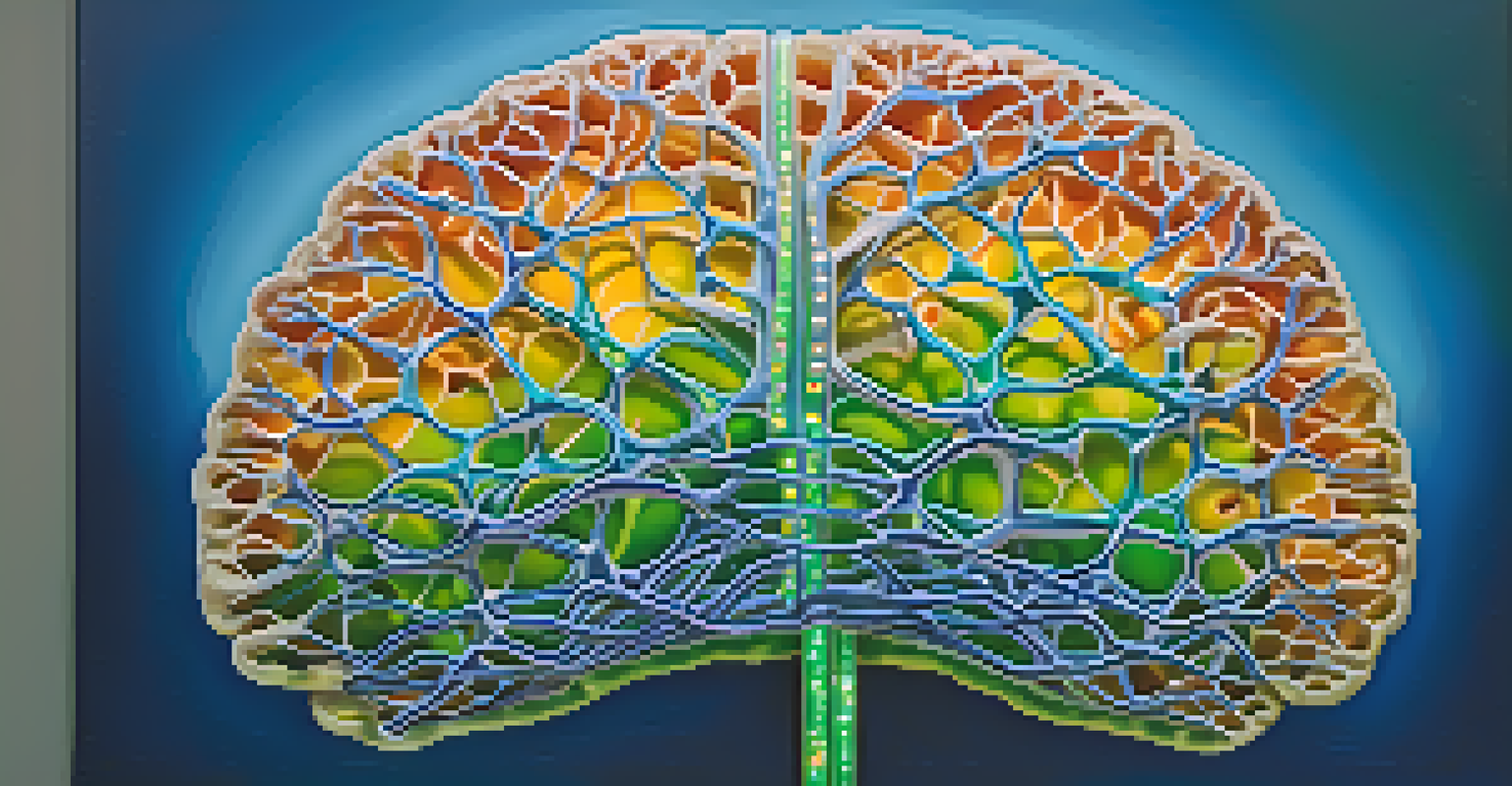Understanding the Neuroendocrine Effects of Psychedelic Drugs

What Are Psychedelic Drugs? A Brief Overview
Psychedelic drugs, like LSD and psilocybin, are substances that can alter perception, mood, and cognitive processes. They primarily affect the brain's serotonin receptors, leading to profound changes in consciousness. These alterations have intrigued researchers and users alike, prompting a closer look at their potential therapeutic benefits and risks.
Psychedelics can provide profound insights into the nature of consciousness, and the interplay between the mind and body is at the heart of this exploration.
Understanding what qualifies as a psychedelic is essential, as these substances can exist in various forms, including natural sources like mushrooms or synthetic creations. Their effects can range from visual hallucinations to feelings of interconnectedness with nature. This diversity in experience opens the door for exploring how these drugs impact not just the mind, but the body as well.
As we delve deeper into the neuroendocrine effects of these substances, it's crucial to note their historical context. Psychedelics have been used in spiritual and healing practices for centuries, and their resurgence in modern research highlights the balance between ancient wisdom and contemporary science.
The Neuroendocrine System: A Quick Explanation
The neuroendocrine system is a complex network that links the nervous system and the endocrine system, which is responsible for hormone production. This system plays a vital role in regulating numerous bodily functions, including stress response, metabolism, and mood. By understanding this connection, we can better appreciate how psychedelic drugs might influence both mental and physical health.

Hormones, such as cortisol and oxytocin, can be affected by the neuroendocrine system, impacting how we feel and behave. When psychedelics enter the picture, they could potentially shift the balance of these hormones, leading to unique psychological outcomes. For example, the release of oxytocin, often referred to as the 'love hormone,' can foster feelings of empathy and connection during a psychedelic experience.
Psychedelics Alter Consciousness
Psychedelic drugs like LSD and psilocybin can profoundly change perception, mood, and cognitive processes by affecting serotonin receptors in the brain.
This intricate relationship between the neuroendocrine system and psychedelics suggests that these substances could offer more than just altered states of consciousness. They may also hold the key to understanding emotional regulation and trauma healing, making this research area particularly fascinating.
How Psychedelics Affect Neurotransmitter Levels
Psychedelic drugs primarily influence neurotransmitters, particularly serotonin, a key player in mood regulation. By binding to serotonin receptors, these substances can lead to a surge in serotonin levels, which may explain the feelings of euphoria and connection many users report. This alteration in neurotransmitter levels is a crucial aspect of understanding their neuroendocrine effects.
The brain is a very complex organ, and the effects of psychedelics on the neuroendocrine system may hold keys to understanding our emotional and mental health.
Additionally, psychedelics can also impact other neurotransmitters, such as dopamine and norepinephrine. These changes can create a ripple effect throughout the brain, influencing everything from attention to emotional responses. This interplay between neurotransmitters and the neuroendocrine system is what makes the study of psychedelics so complex yet rewarding.
As more research unfolds, we may discover how these shifts in neurotransmitter levels could be harnessed for therapeutic purposes. For instance, understanding how psychedelics affect serotonin could lead to new approaches for treating depression and anxiety, conditions often tied to neuroendocrine dysfunction.
The Role of the HPA Axis in Psychedelic Experiences
The hypothalamic-pituitary-adrenal (HPA) axis is a critical component of the neuroendocrine system, governing our body’s response to stress. Psychedelics can impact the HPA axis, influencing hormone release and stress responses. This connection is vital when considering the potential therapeutic effects of these substances on anxiety and stress-related disorders.
When psychedelics are consumed, they may alter the HPA axis's functioning, potentially leading to decreased cortisol levels, which is the body’s primary stress hormone. This reduction could help break the cycle of chronic stress and its associated health implications. Such findings could revolutionize our understanding of stress management and mental health treatment.
Neuroendocrine Impact on Health
The neuroendocrine system's interaction with psychedelics suggests these substances may influence hormonal balance, potentially aiding in emotional regulation and trauma healing.
Exploring the relationship between psychedelics and the HPA axis opens exciting possibilities for future research. It suggests that these substances might not only provide temporary relief from stress but could also encourage long-term changes in how our bodies respond to stressors.
Psychedelics and Hormonal Changes in the Body
Psychedelics can lead to significant hormonal changes within the body, affecting various systems and functions. For example, research indicates that psychedelics may increase levels of hormones like prolactin and oxytocin, which are associated with bonding and emotional regulation. This hormonal shift can contribute to the feelings of connection and empathy reported during psychedelic experiences.
Furthermore, these hormonal changes may help explain the therapeutic potential of psychedelics in treating conditions like PTSD and depression. By fostering emotional connections and reducing feelings of isolation, psychedelics could play a role in healing trauma and enhancing overall well-being. This link between hormones and mental health is an area that warrants further exploration.
Understanding how psychedelics impact hormonal fluctuations can provide insights into their broader effects on the body. It underscores the importance of a holistic view when considering the implications of these substances, as their influence extends beyond the mind and into our physical health.
Potential Benefits of Psychedelics in Therapy
Recent studies have shown that psychedelics may offer promising benefits in therapeutic settings, particularly for mental health disorders. By modulating the neuroendocrine system, these substances can potentially help individuals process trauma, reduce anxiety, and improve mood. This emerging field of psychedelic therapy is gaining traction, as more research supports its efficacy.
One fascinating aspect of psychedelic therapy is its ability to promote neuroplasticity, which is the brain's capacity to reorganize itself by forming new neural connections. This neuroplasticity, coupled with hormonal changes, may facilitate breakthroughs in therapy, allowing patients to approach their issues from a fresh perspective. Such transformative experiences can be life-changing for those struggling with mental health challenges.
Therapeutic Potential of Psychedelics
Emerging research indicates that psychedelics could provide significant therapeutic benefits for mental health disorders by promoting neuroplasticity and emotional connections.
However, it's essential to approach this field with caution. While the potential benefits are significant, further research is needed to ensure safe and effective practices in using psychedelics for therapeutic purposes. Balancing enthusiasm with careful study will be crucial for the future of psychedelic therapy.
The Future of Research on Psychedelics and Neuroendocrinology
The intersection of psychedelics and neuroendocrinology is an exciting frontier in scientific research. As societal attitudes towards psychedelics shift, more funding and interest are being directed toward understanding their mechanisms of action within the body. This growing curiosity presents an opportunity for groundbreaking discoveries that could reshape our approach to mental health and well-being.
Future studies may delve deeper into how different psychedelics affect various aspects of the neuroendocrine system. By examining specific hormones and their interactions with psychedelic experiences, researchers could unveil new therapeutic pathways. This knowledge could lead to tailored treatments for a range of mental health conditions, enhancing the effectiveness of psychedelic therapy.

As we look ahead, the potential for psychedelics to revolutionize our understanding of mental health is immense. The ongoing research promises to shed light on the complex relationship between these substances and our neuroendocrine system, paving the way for innovative and impactful treatments.